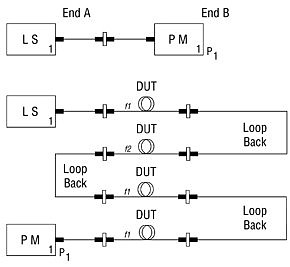10D: Single-direction Loop-back
Loss Using a Source & Meter, or One LTS



 Introduction
Introduction
In this example, characterisation is performed from one end of a link, so it is generally much faster than Example 1. The other end is looped back. The pass / fail uncertainty of each fiber increases as more loops are added, so this method is best suited to situations where relaxed specifications can be accepted. Therefore, this may be unsuitable for long distance links. This arrangement may also be useful to verify links while jumping a repeater site.
The Bi-directional method could also be performed easily, which would help compensate for the reduced accuracy.
Communication from end to end is not required.
It makes very little difference if a source and meter, or an integrated LTS is used.
Method
The actual method of operation is the same as Example 1, except that:
- The DUT comprises two or more fibers, and loop-backs need to be arranged.
- Allowance needs to be made for extra loop back losses.
- Due to the higher uncertainty, marginal results may require additional validation using Example 1.
In this situation ‘Autotest’ type features can result in better measurement confidence, lower skill requirements and twice the productivity for dual wavelength measurements, since both wavelengths are measured in one operation.

Key
 |
Connectorised link |
 |
Patch Cord |
 |
Through adaptor |
 |
Source, incl. mandrel wrap if multimode |
 |
Meter |
 |
DUT Device Under Test (system being tested) |
[instructions on use of the relative mode are in italics]